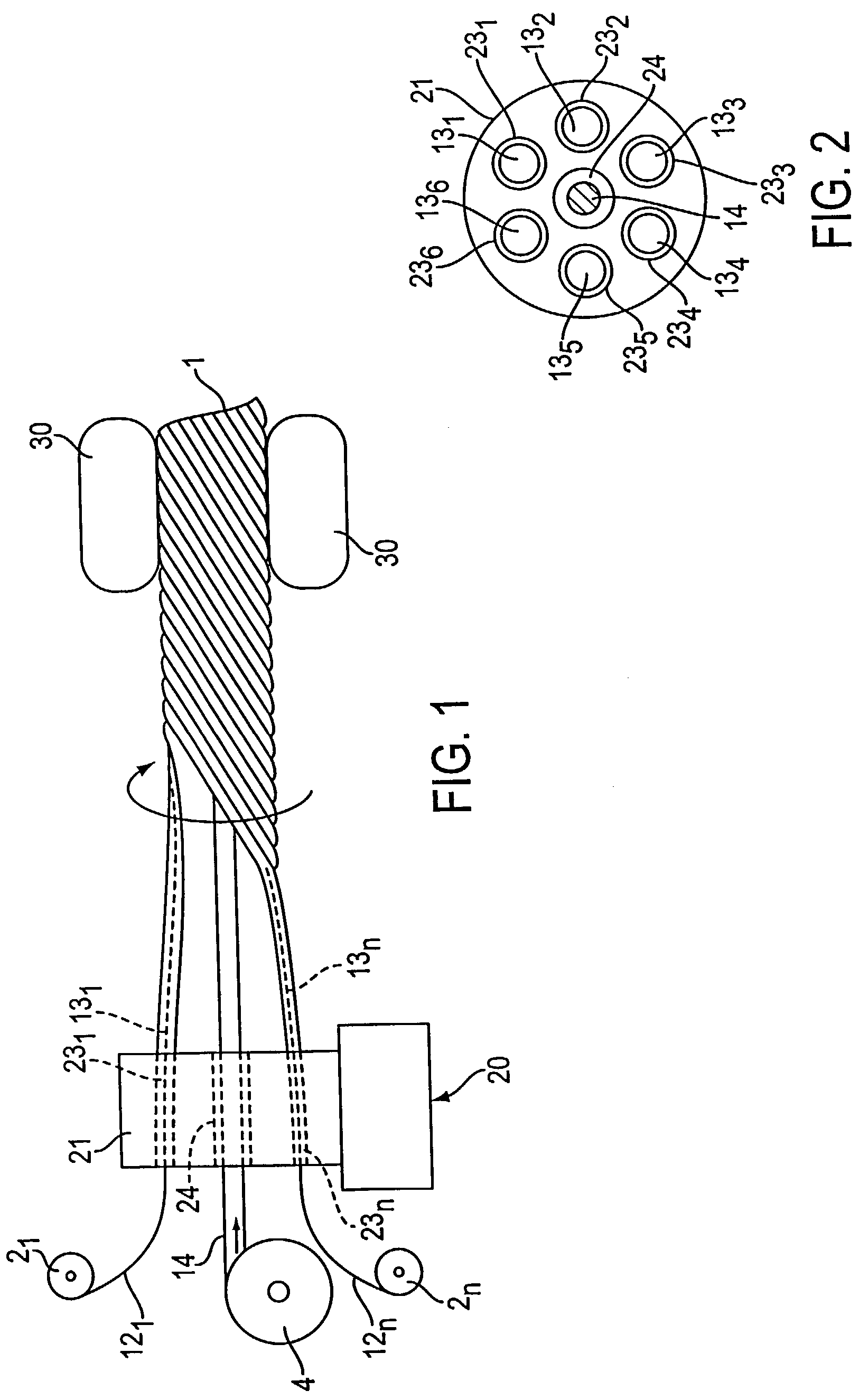[0017]An object of the present invention is to overcome the disadvantages of the related art. In particular, it is an object of the present invention to increase line speed and decrease cost in the production and use of flextube units, or optical cables.
[0018]The present invention achieves the above and other objects and advantages by providing a new process, in manufacturing optical cables, called solid-stranding. The process of solid-stranding is a one-step process for extruding multiple loose tubes or flextubes (hereinafter simply referred to as flextubes for convenience) and stranding the tubes in
helical or SZ stranded arrangement prior to winding the optical cable on a take-up reel. The method and apparatus of the present invention, for solid-stranding, combine together buffering and stranding operations, as well as perform the stranding operation while the supporting sheaths of the flextubes are still hot so that they adhere together without additional binders. In particular, optical fibers and / or wires are supplied to an extruder which forms supporting sheaths around individual ones or groups of the optical fibers and / or wires. A central element is supplied through the center of the extruder. A rotating pulling device, such as a
caterpillar, helically strands the flextubes around the central element as the sheaths cool down. That is, in the new solid-stranding process of the present invention, buffering and stranding operations are performed together without a cooling stage therebetween so that the flextubes contact one another and the central element at a temperature which is between the process temperature and the
melting point of the material from which the flextubes are made. The process temperature is that of the material in the extruding die and, typically, is 20–50° C. above that material's
melting point, wherein the
melting point is typically a range of temperatures over which the material melts. Although the melting point is actually a range of temperatures over which the material melts, the term “melting point” is used for convenience. Thus, because the flextubes are brought together at a temperature which is between the process temperature and the melting point, they adhere together forming a composite core. The composite core then may be jacketed by passing through another extruder, or may be used without a jacket, thereby forming a flextube unit from which individual flextubes easily may be split.
[0019]Because there is no need to completely cool the flextubes before they are stranded, and the flextubes have a relatively thin supporting sheath wall,
water cooling of individual flextubes can be replaced by
air cooling the composite core. That is, cooling
water right after
extrusion becomes unnecessary. Therefore, any water swellable elements used in the flextube unit are not damaged. Additionally,
air cooling—as opposed to water cooling—the flextubes may help to improve the breakability and split of the supporting sheath, when it is desired to do so. That is, water cooling may undesirably change the mechanical behavior of some polymers, like those based on
polypropylene (PP). Such undesirable change in mechanical behavior is eliminated by
air cooling the flextubes after they have been stranded together.
[0020]Further, solid-stranding—wherein buffering and stranding are performed in the same process—shortens manufacturing time. That is, skipping the cooling stage—wherein individual flextubes are formed, which must then be combined in a stranding phase—increases production speed.
[0021]Moreover, solid-stranding forms a composite core which eliminates the need for separate binders to hold the flextubes together. Conventional cable designs produced by separate buffering and stranding processes may use a minimum of one binder—typically a
polyester yarn—to secure all the loose tubes or flextubes during the tube stranding step. The binder allows the tubes to remain at desirable locations, such as in helically or SZ-stranded arrangements. However, the binders add costs in manufacturing material and equipment, as well as
labor burden in the field to remove the binder prior to accessing the tubes. Because separate binders are not necessary in the solid-stranding process of the present invention, production speed is further increased and, at the same time, production cost is reduced. Further, such results in a lower cost optical cable, the tubes and optical fibers of which can be more easily accessed in the field thereby reducing labor costs involved with use and repair of the optical cable.
[0022]The solid-stranded flextubes may be continuously helically stranded in one direction, or may change stranding directions to form an SZ-stranded composite core. Further, the central element may be a water swellable
yarn, a ripcord, or itself may be a flextube having optical fibers therein. Alternatively, the central element may be a metallic or other
heat conducting member. In this case, the central element can be heated to further promote adhesion between the flextubes stranded around it, as well as to assist in sticking the flextubes to the central member.
 Login to View More
Login to View More 


